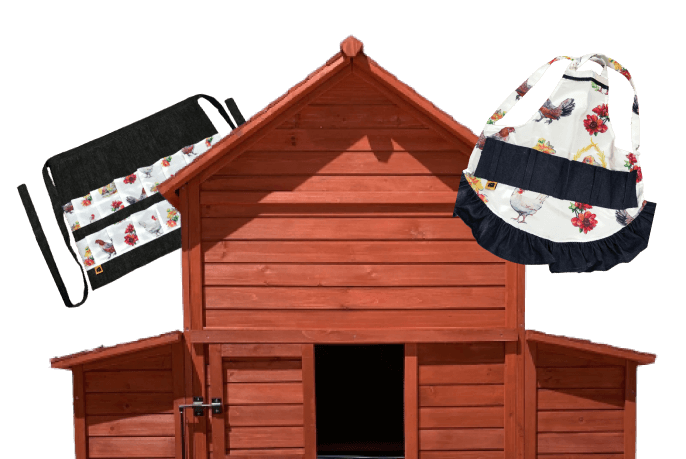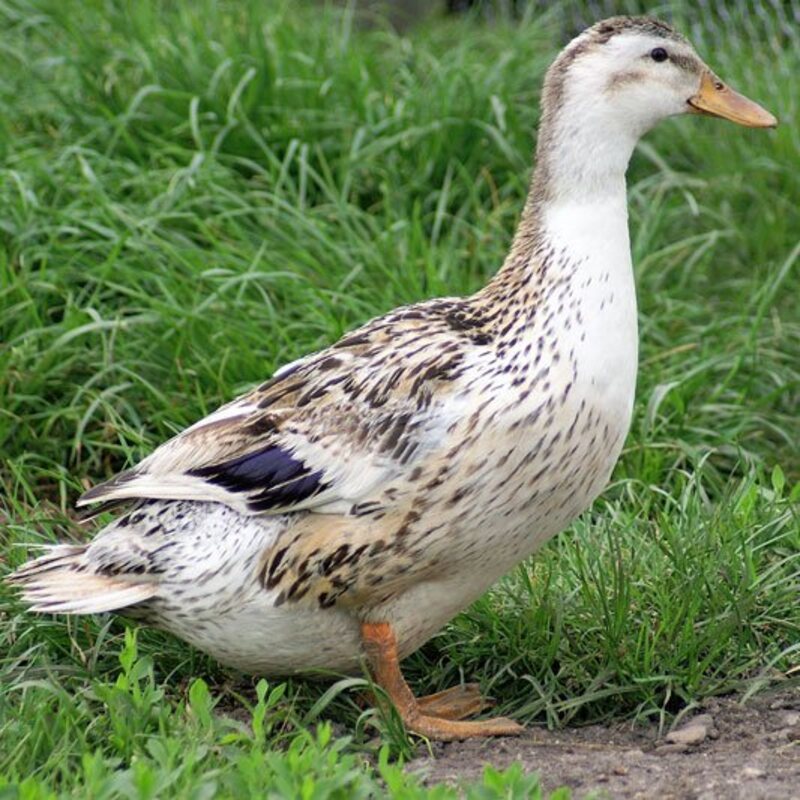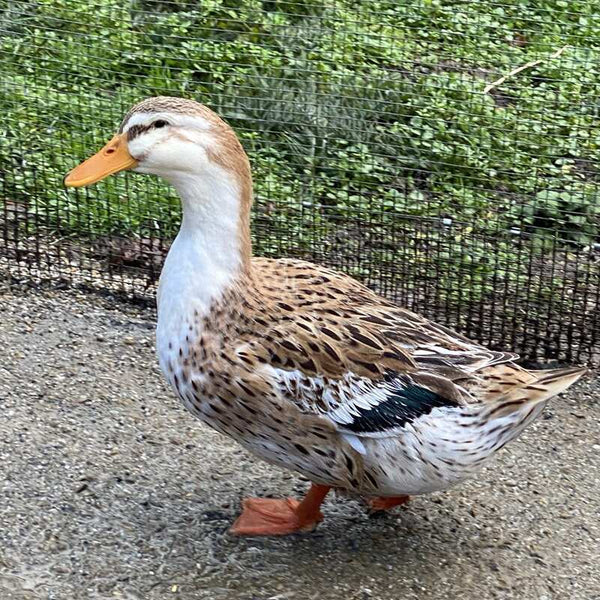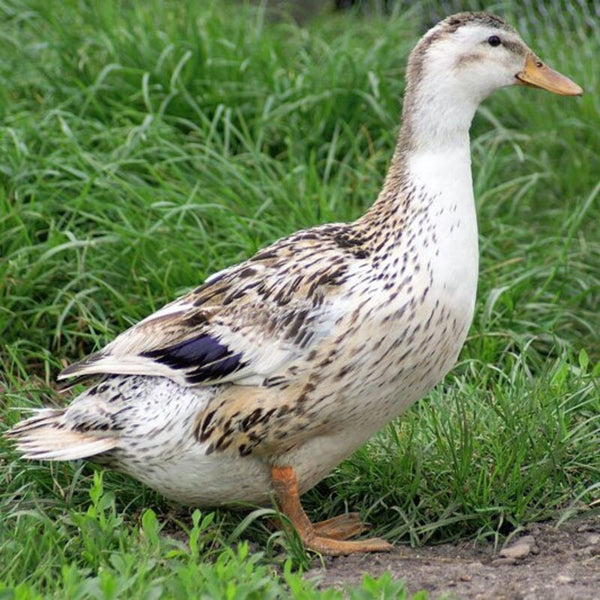Silver Appleyard Ducks
Silver Appleyard Ducks
The Silver Appleyard Duck is an easygoing, versatile breed ideal for both small and large flocks. Known for rapid growth and excellent egg-laying capabilities, it’s a great choice for dual-purpose use, providing both eggs and meat. This breed originated in the 1930s in England, developed by Reginald Appleyard, and was introduced to the USA in the late 1960s.
The Silver Appleyard gained popularity and was accepted into the American Poultry Standard of Perfection in 1998. With a typical egg production of 200–270 eggs per year, this duck can also go broody, successfully raising 8–12 ducklings. Female Appleyards are easily recognizable within a flock due to their lighter coloration, often compared to a light-colored Mallard with silver-white on the face, neck, and breast.
Appearance
Feather Color:
Drakes have white, chestnut and silvery-grey feathers with a dark green head and white neck ring. Hens are more subdued with silver-white feathers and subtle penciling. Clean and refined.
Body Type:
Medium to large. Broad and deep with strong, upright frame. Good for meat and eggs. Not as big as commercial breeds like Pekins but a good balance of size and productivity for small scale or backyard.
Head and Beak:
Proportionate head with slightly rounded shape. Drakes have greenish bill, hens have orange or slate beak.
Legs and Feet:
Strong orange legs with webbed feet. Good for land and water. Legs set wide for deep body.
Size:
Males 8-10 pounds, females 7-9 pounds. Not as big as heavy meat ducks but good meat yield and laying performance.
Temperament
Calm and Friendly:
Silver Appleyards are gentle and social. Easy to handle especially when raised from ducklings. Get along with other ducks and poultry so good for mixed flocks on family farms and homesteads.
Active and Alert:
Curious and moderately active. Like to explore, forage and socialize without being too noisy or flighty.
Great for Free-Range Systems:
Good for pasture based systems where they can forage for insects and plants. Adaptable to confinement too as long as they have space and enrichment.
Egg Production
Prolific Layers:
Silver Appleyards are one of the best laying breeds of heavyweight ducks. Lay around 200-270 white eggs per year, mostly in spring and summer.
Egg Quality:
Eggs are large, white and good for eating and baking. Duck eggs have richer flavor and higher fat content than chicken eggs so good for cooking.
Laying Consistency:
Reliable layers with strong laying season in warmer months. Some may lay through winter if given supplemental light and care.
Hardy:
Silver Appleyards are tough birds that can take cold and heat. Their dense feathering protects them in winter and their foraging habits keep them healthy in warm seasons.
Low Maintenance:
Need a balanced diet of waterfowl pellets, grains and fresh greens. Access to clean water for drinking, bathing and feather condition.
Health Monitoring:
Like all ducks, they should be checked regularly for parasites (mites, lice) and common issues like bumblefoot or waterborne diseases. Clean, dry bedding and good sanitation helps maintain flock health.
Housing
Space Requirements:
Do best when they have room to roam. Thrive in free-range but also adapt well to pens or coops with attached runs. A secure area helps reduce stress and keep them productive.
Access to Water:
Need clean water for hygiene and health. A small pond or even a kiddie pool is ideal for swimming which keeps their feathers in top condition.
Predator Safety:
Their calm and trusting nature makes them vulnerable to predators like raccoons and hawks. A well fenced, locked coop for nighttime security is essential.
Show and Ornamental Use Space Requirements:
Poultry Shows:
Accepted by poultry standards in UK and US, Silver Appleyards are sometimes shown for their refined appearance especially drakes with their colorful plumage.
Ornamental Value:
While a utility breed, their striking coloration and calm nature makes them a beautiful addition to ornamental flocks and hobby farms.
Frequently Asked Questions:
Is the Silver Appleyard Duck a rare breed?
Yes, while it has gained recognition, it’s still considered relatively rare.
Are Silver Appleyard Ducks docile?
Yes, they are generally friendly and easy to manage.
Do Silver Appleyard Ducks go broody?
Yes, they can go broody and will often raise 8–12 ducklings.
Are Silver Appleyard Ducks cold hardy?
Yes, they are well-suited to cold climates.
Are Silver Appleyard Ducks large or small?
They are a medium-to-large breed, making them ideal for dual-purpose use.
Silver Appleyard Ducks Facts
- Poultry Show Class: Ducks, Heavy Weight
- Weights: Hen—-7 lbs
- Drake—-9 lbs
- Purpose and Type: Egg and Meat Production; Exhibition
- Egg Color: White
- Egg Production: 120-175 per year
- Egg Size: Large to Extra Large
- Temperament: Calm
- Gender Accuracy: 90%
- Fertility Percentage: 60-75%
- Broody: Setters
- Mating Ratio: 6 Females to 1 Male
- Roost Height: Floor
- Country of Origin: England
- APA: Yes, Recognized by the Standard of Perfection in 1998
- TLC: Watch Status, Considered a Sustainable Heritage Duck Breed
- Breeder Farm Source: Poultry Breeding Farm developing our bloodlines or strain of Silver Appleyard Duck Breed since 2015.
Notice: We do not sell items on Amazon or other websites.






